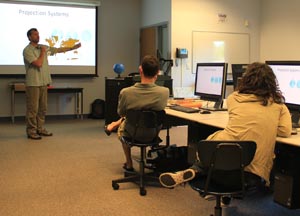

And this semester, many University of Michigan-Dearborn students can experience it for the first time. In a few weeks, UM-Dearborn’s Geographic Analysis and Mapping (GAM) lab will welcome students for its first full semester of classes.
The College of Arts, Sciences, and Letters invested in the lab to ensure that students, as well as faculty and staff, are exposed to geospatial technology, including GPS, geographic information systems (GIS), satellite remote sensing and applications such as Google Earth.
“If we want our students to compete for jobs, we’ve got to offer them state-of-the-art technology,” said Jacob Napieralski, director of UM-Dearborn’s GIS program and associate professor of geology.
And there are plenty of jobs to compete for when it comes to GIS. The U.S. Bureau of Labor Statistics ranked geospatial technology as one of the three emerging fields in the 21st century, Napieralski said.
“They’ve been predicting a growth in the GIS industry for quite some time now,” he said. “Young people who have this sort of training, out in the workforce, are very marketable.”
Napieralski, along with geology lecturer Justin Saarinen and geography lecturer Claudia Walters, train students who are interested in using GIS at the municipal, state and federal level, as well as in graduate schools and consulting firms.
An increasing number of job descriptions in local government agencies and private businesses are being rewritten to require employees to use GIS in geography, urban planning, watershed planning and management, civil engineering, surveying, landscape architecture, environmental science, geoscience and related fields.
And as more students get wind of the job growth, enrollment is expected to increase.
“With this new GIS lab, we’ve got a facility and we’ve got lots of eager students and faculty who share a common interest,” Napieralski said.
The GAM lab, located in the Social Sciences Building, also has generated interest from outside organizations, including some government agencies that are interested in partnering with UM-Dearborn on various projects.
“We are starting to get attention from some agencies around the region that are involved with Great Lakes research,” said Saarinen, who also is an assistant research scientist at UM-Dearborn. “They’re interested in not only access to a lab where cutting edge geospatial research is done, but they’re also excited about working with bright students and involved professors.”
That could result in more student internship opportunities, Saarinen said.
“This is a brand new lab without a strong purpose, outside of teaching,” he said. “That’s what’s really special about this place. This is a brand new baby that’s ready to have some identity.”
More information on the GAM Lab.





